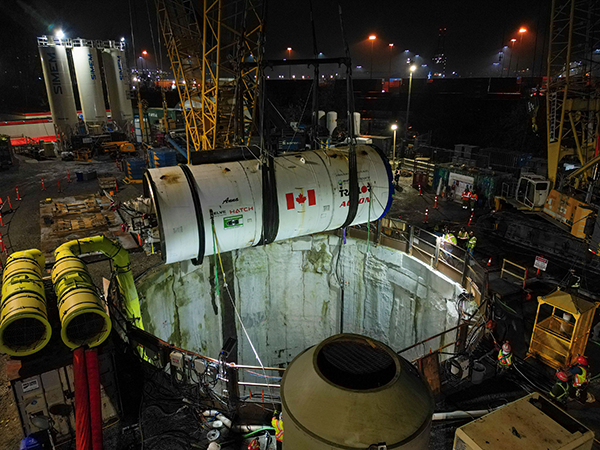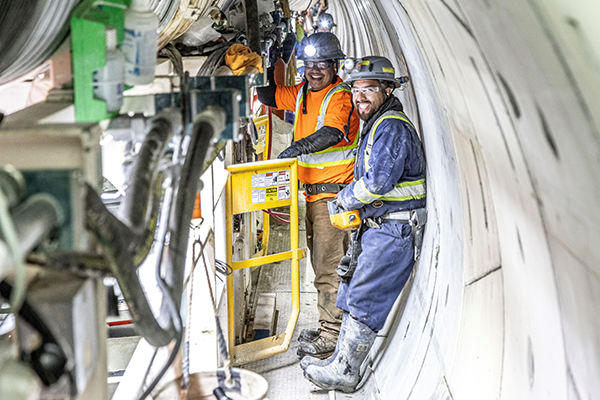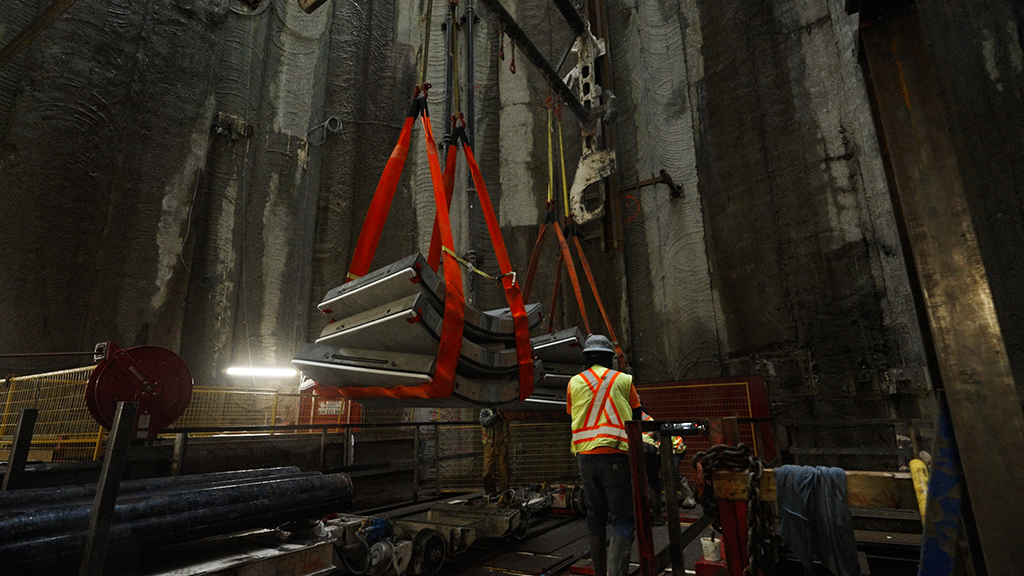Most construction sites are above ground or, in the case of an excavation, still visible from the surface.
A site just north of Annacis Island in B.C., though, is 50 metres deep and under the Fraser River.
The project is the $450-million, 2.3-kilometre-long Annacis Water Supply Tunnel between New Westminster and Surrey that is being built to remain operational if a major earthquake strikes the area.
A single tunnel-boring machine named Anna is currently churning away at the rock below the surface and advancing several metres each day. It is presently nearing the New Westminster exit.
Construction on the tunnel began in 2022 and it is expected to take six years to complete.
The tunnel is being built for Metro Vancouver by the Traylor-Aecon General Partnership, a collaboration between Traylor Infrastructure Canada, ULC and Aecon Infrastructure Inc.
“The speed changes based on soil conditions,” says project manager Keith Threadkell. “On average, the tunnel boring machine has been excavating about 15 metres a day.”

Each workday, a small army of construction workers hops aboard rail cars and heads into the depths of the tunnel.
“There are upwards of approximately 120 workers involved on the project at peak periods,” explains Threadkell. “This includes field workers and office support workers.”
The contingent includes labourers, heavy equipment operators, electricians, mechanics, welders, carpenters, iron workers, drillers, specialized underground workers and saturation divers.
The tunnel-boring machine drills for 20 hours a day, six days a week. Above, there are geo-technical stations that monitor the ground to make sure everything is safe.

“Construction is progressing well, and we are on schedule to complete the project in 2028 within budget,” says Threadkell.
The tunnel is one of five key crossings the regional district prioritized after a review of seismic hazards in its water network. The crossings are being designed to withstand a one-in-10,000-year return period earthquake, or the magnitude-nine earthquake that is frequently talked about.
The tunnel will ensure there’s enough drinking water for the growing population in the area for 100 years.
To construct the tunnel, a vertical entry shaft was excavated on the south side of the river at a site on Grace Road in Surrey, followed by a vertical exit shaft on the north side at 11th Street in New Westminster. The tunnel boring machine was launched from the entry shaft in Surrey in early 2024.
The Surrey shaft is about 50 metres deep and 15 metres in diameter and the New Westminster shaft is about 60 metres deep and nine metres in diameter. The tunnel-boring machine is 4.7 metres in diameter and the inside diameter of the precast segmental concrete liners is 3.9 metres.
As the tunnel-boring machine progresses, the liners or large ring segments are installed to reinforce the tunnel and support the ground. There are six segments per ring, with each separate piece weighing more than 1,400 kilograms. On average 15 rings are installed each day. The tunnel will need 1,800 rings. Each segment is lowered down the shaft and taken by train down the tunnel.
As the tunnel-boring machine advances under the river, excavated clay and mud is loaded into train cars and removed.
Once tunnelling is complete, crews will extract the tunnel-boring machine. After the machine is removed and the tunnel is cleaned, Threadkell says crews will then spend a year installing a 2.6-metre-diameter steel watermain inside the new tunnel and shafts.
In addition, specialized crews will begin constructing an underground valve chamber near each shaft so that the new watermain can be connected to the regional water transmission system. It will take approximately two years to build each valve chamber.
Final steps include connecting the new watermain to the existing regional water distribution system and restoring the two shaft sites. Restoration will include creating a new green space in New Westminster and replanting trees in Surrey
Threadkell says the location and depth of the shafts and tunnel, along with the materials used for the pipe and valve chamber, have been designed to ensure the new crossing will be able to withstand a major earthquake.
As with any tunnelling project, the Annacis project has faced some challenges. The tunnel is deep as it has to go under the river and must pass between highrises and under SkyTrain lines before reaching the surface near New Westminster’s 11th Street and Royal Avenue.
Digging the tunnel has also meant boring through deposits left thousands of years ago by retreating glaciers.
According to Threadkell, a challenge associated with tunnelling at such a depth is the significant ground pressures that are encountered.
The solution?
“To overcome this, the contractor uses an excavation methodology called Earth Pressure Balance,” he says. “This involves using the excavated material to support the tunnel face and maintain a balanced pressure.”




Recent Comments